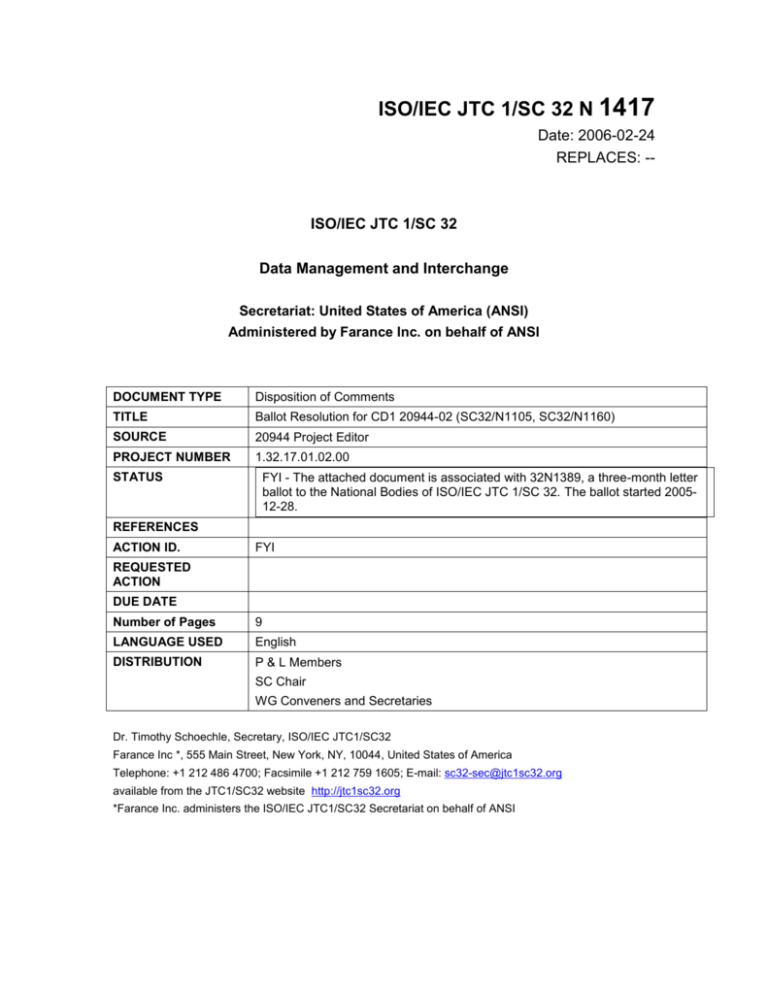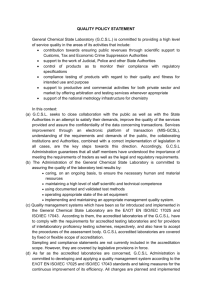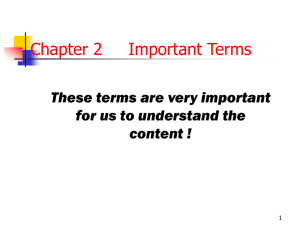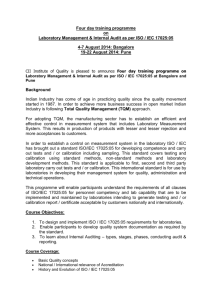Ballot Resolution for CD1 20944
advertisement

ISO/IEC JTC 1/SC 32 N 1417 Date: 2006-02-24 REPLACES: -- ISO/IEC JTC 1/SC 32 Data Management and Interchange Secretariat: United States of America (ANSI) Administered by Farance Inc. on behalf of ANSI DOCUMENT TYPE Disposition of Comments TITLE Ballot Resolution for CD1 20944-02 (SC32/N1105, SC32/N1160) SOURCE 20944 Project Editor PROJECT NUMBER 1.32.17.01.02.00 STATUS FYI - The attached document is associated with 32N1389, a three-month letter ballot to the National Bodies of ISO/IEC JTC 1/SC 32. The ballot started 200512-28. REFERENCES ACTION ID. FYI REQUESTED ACTION DUE DATE Number of Pages 9 LANGUAGE USED English DISTRIBUTION P & L Members SC Chair WG Conveners and Secretaries Dr. Timothy Schoechle, Secretary, ISO/IEC JTC1/SC32 Farance Inc *, 555 Main Street, New York, NY, 10044, United States of America Telephone: +1 212 486 4700; Facsimile +1 212 759 1605; E-mail: sc32-sec@jtc1sc32.org available from the JTC1/SC32 website http://jtc1sc32.org *Farance Inc. administers the ISO/IEC JTC1/SC32 Secretariat on behalf of ANSI AUSTRALIA AU TE Comment - Major The organisation of this multipart standard is quite unwieldy and Unnecessarily so. It suggests 29 different parts with gaps in numbering for future usage, see extract below from N1102. There is a logical grouping for these parts as can be seen in the table in the introduction also extracted below. We suggest the multipart standard be collapsed into a small number of logical groupings as indicated in the document. This would yield just 5 parts to this standard, with the consequential savings in administration and management of the standard as well as improving the usability of it. See response to Australia's comment in Part 01. The 5 parts would be: 1. Overview and Common Aspects 2. Coding Bindings 3. API Bindings 4. Protocol Bindings 5. Profiles Part 002: Common vocabulary There are two major Comments: Comment 1 This standard is largely a cross reference to terms defined elsewhere. Section 3 is the body of the document. 19 of the 20 sections refer to terminology in the following list from the Normative References, and in section 19 many of the items have references to other standards ISO/IEC Guide 2, Standardization and related activities ? General vocabulary ISO/IEC 704:2000, Terminology work ? Principles and methods ISO/IEC 1087-1:2000, Terminology work ? Vocabulary ? Part 1: Theory and application ISO/IEC 2382 (all parts), Information technology ? Vocabulary ISO/IEC 10241:1992, International terminology standards ? Preparation and layout ISO/IEC 11179 (all parts) At the time of publishing, some parts of ISO/IEC 11179 are being revised., Information technology ? Metadata Registries (MDR) The international standards, technical reports, and drafts of the 11179, 20943, and 20944 series are available at http://metadata-standards.org/11179 http://metadata-standards.org/20943 http://metadata-standards.org/20944 ISO/IEC 11404:1996, Information technology ? Programming languages, their environments, and system software interfaces ? Languageindependent datatypes ISO/IEC 14977:1996, Information technology ? Syntactic metalanguage ? Extended BNF It seems unnecessary to copy all this terminology from other sources. The document should simply reference it and concentrate on terminology unique to the 20944 family in its context. BALLOT RESOLUTION: Will identify terms used within the standard vs. terms used by users of the standard. Comment 2 - Major Comment on the forward and introduction to N1105 The organisation of this multipart standard is quite unwieldy and unnecessarily so. It suggests 29 different parts with gaps in numbering for future usage, see extract below from N1102. There is a logical grouping for these parts as can be seen in the table in the introduction also extracted below. I suggest the multipart standard be collapsed into a small number of logical groupings as indicated in the document. This would yield just 5 parts to this standard, with the consequential savings in administration and management of the standard as well as improving the usability of it. The 5 parts would be: 1. Overview and Common Aspects 2. Coding Bindings 3. API Bindings 4. Protocol Bindings 5. Profiles Extract from N1105: - Part 001: Framework - Part 002: Common vocabulary - Part 003: Common provisions for conformance - Part 004: Generic usage - Part 005: Common data structures and services - Part 006: Semi-structured aggregation - Part 020: Common provisions for coding bindings - Part 021: XML coding binding - Part 022: DIVP coding binding - Part 023: ASN.1 coding binding - Part 040: Common provisions for application programming interface (API) bindings - Part 041: C API binding - Part 042: C++ API binding - Part 043: Java API binding - Part 044: ECMAscript API binding - Part 045: Perl binding - Part 046: LISP binding - Part 047: PHP binding - Part 060: Common provisions for protocol bindings - Part 061: ODBC protocol binding - Part 062: DCTP protocol binding - Part 063: SOAP protocol binding - Part 064: WSDL protocol binding - Part 065: LDAP protocol binding - Part 066: JMS protocol binding - Part 100: Common provisions for profiles - Part 101: Attribute mapping for 11179-3 metadata registry metamodel - Part 102: Profile for 11179-3 metadata registry metamodel - Part 103: Uniform Resource Identifier (URI) suffixes for 11179-3 metadata registry metamodel navigation Table extract from 1105 BALLOT RESOLUTION: See response to Australia's comment in Part 01. CANADA Project: 1.32.17.01.02.00 Title: Canadian Ballot Comments on CD 20944-02 (32N1105) Status: Approved Canadian Ballot Comment Date: February 15, 2016 1. INTRODUCTION Canada votes "DISAPPROVAL FOR THE REASONS ATTACHED" on ISO/IEC CD 20944-02 (N1105). Canada will change its vote to APPROVAL if the attached comments are satisfactorily addressed. 2. BALLOT COMMENTS The following are the Canadian comments on ISO/IEC CD 20944-02 (N1105) As agreed at the 2000 Manhattan meeting of WG2, Canada has used the ballot comment format defined by WG2 SD-006 and therefore the following ballot comments are sorted by sub-clause number with those comments that apply to the whole document at the beginning. The columns in the document have the following meanings: SEQ # — A sequence number indicating the total number of comments – for use by the editor when consolidating comments. Cmnt ID — The comment identifier assigned by the organization submitting the comment See Also — Pointers to (comment identifiers of) other comments that appear to be closely related Severity — The severity of the problem as stated by the organization submitting the comment Reference — The location in the balloted document that the organization identified as most pertaining to the comment Description — The description provided by the organization with the comment; this includes any proposed solution provided by the organization Addressed By — For use by the Editor during and following the editing meeting. SEQ # Cmnt ID See Also Severity Reference Description JTC1/SC32 N1105 CD 20944-02 CAN-P02-001 0-General 00-All While Canada supports the consolidation of the vocabulary in a common part, we believe there is a need for at least a list of the terms in each individual part, so that the reader knows which terms can be found in part 2. Once each part reaches FCD, we should add references to the specific sub-clauses in part 2 where the definitions can be found. If part 2 progresses too far ahead of other parts, it will become difficult to keep it harmonized with parts that are significantly behind it in progression. Therefore, we should plan to progress as many parts as possible simultaneously. The concept of the "release sequence" that the editor is using to show which versions of which parts are harmonized is of great value in accomplishing this, but we also need to expedite the progression of other parts. Part 2 should not be allowed to progress to FCD until most other parts are at least at first CD. CAN-P02-002 0-General 00-All We will comment on specific definitions when we see how the terms are used in context in other parts. This is another reason that this part should not progress any further until the CDs of the other existing parts have been issued. CAN-P02-003 4-Minor Editorial 00-All The SC32 Secretariat has requested that the part numbers be expressed as two digits rather than three, because that is all his software can handle. Proposed Solution Throughout the document, remove leading zeroes from all three digit parts numbers. Parts 100-103 are to be renumbered to 80-83 CAN-P02-004 4-Minor Editorial 00 Foreword The title of Part 40 should be changed to "Common provisions for API bindings", as agreed in Xi'an. CAN-P02-005 4-Minor Editorial 00 Foreword The title of Part 45 should be "Perl API binding". CAN-P02-006 4-Minor 00 Foreword The title of Part 46 should be "LISP API binding". Addresse d By SEQ # Cmnt ID See Also Severity Reference Description Editorial CAN-P02-007 4-Minor Editorial 00 Foreword The title of part 81 (listed as 101) should be changed to "Attribute mapping for 11179-3 MDR metamodel, as agreed in Xi'an. CAN-P02-008 4-Minor Editorial 00 Foreword The title of part 82 (listed as 102) should be changed to "Profile for 11179-3 MDR metamodel", as agreed in Xi'an. CAN-P02-009 4-Minor Editorial 00 Foreword The title of part 83 (listed as 103) should be changed to "URI suffixes for 11179-3 MDR metamodel navigation", as agreed in Xi'an. CAN-P02-010 4-Minor Editorial 00 Introduction The Figure should be replaced by the updated Figure developed in Xi'an. CAN-P02-011 4-Minor Editorial 02 Normative References Add a reference to the ISO/IEC Directives Part 2 because they are referenced from clause 3.2. CAN-P02-012 4-Minor Editorial 02 Normative References Add a reference to the ISO/IEC JTC1 Directives because they are referenced from clause 3.3. CAN-P02-013 4-Minor Editorial 02 Normative References Add a reference to the ISO/IEC TR 10000-1 because it is referenced from clause 3.3. CAN-P02-014 4-Minor Editorial 02 Normative References Add a reference to the ISO/IEC TR 10000-1 because it is referenced from clause 3.15. CAN-P02-015 4-Minor Editorial 02 Normative References Add a reference to the ISO/IEC 13886:1995 because it is referenced from clause 3.18. CAN-P02-016 3-Major Editorial 02 Normative References For each term taken from another standard, a reference to the explicit clause in the standard should be added. CAN-P02-017 3-Major Editorial 02 Normative References Many terms are currently included which we may end up not using. When this document goes to FCD, terms which are not yet referenced – and for which there is not a strong likelihood they will be required in a future part – should be removed to avoid cluttering the document. CAN-P02-018 3-Major Editorial 02 Normative References Where a term is shown as being “adapted from” another standard, an Editor’s note should be added explaining how the definition has been adapted, and the rationale for doing so. This will help the working group understand the documents better. We can debate separately whether the note should be included in the final document, for the benefit of the eventual user. CAN-P02-018 4-Minor 03.12.07 The title of this clause is incorrect. It should be “User facilities” (from Addresse d By SEQ # Cmnt ID See Also Severity Reference Editorial Description clause 09.08 of 2382-09). End of Comments Addresse d By





